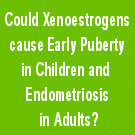|
Endometriosis |
||||||||||||
|
||||||||||||
|
||||||||||||
![]()
The Cause of
Endometriosis
The Root Cause of Endometriosis is Likely to be Xenoestrogens
Endometriosis is endometrial cells (uterine lining cells) that grow in places where they should not be such as the abdominal cavity near the intestines, fallopian tubes, and the ovaries. The cells cycle and bleed with the monthly menstrual cycle. Mainstream medicine readily admits that pregnancy retards or cures endometriosis. This suggests that estradiol plays an important role in stimulating endometriosis. Also, the fact that endometriosis was never described before the chemical age along with the discovery that some synthetic chemicals mimic estrogen(xenoestrogens) also suggests that these xenoestrogens may stimulate endometriosis as well. The solution is to signal the ovary to stop producing estradiol by taking progesterone and fooling the ovary into thinking the body is pregnant, AND avoiding xenoestrogens. Rhesus monkeys fed very small amounts of dioxin developed endometriosis 10 years later. In another study, by the Canadian government, monkeys developed endometriosis from being exposed to PCBs. Endometriosis is now epidemic, but was rare 150 years ago. It's highly likely that endometriosis is environmentally triggered by xenoestrogens (chemicals that mimick estrogen). The question is: Are there anymore chemicals out of the 85,000 in use in the United States that can mimick estrogen. The answer is YES! The solution is to take Natural Progesterone and cut out Estrogen in your environment.
by Elizabeth Smith, M.D.
Monkeys Given Small Amounts of Dioxin Develop Endometriosis 10 Years Later
It is likely that xenoestrogens, chemicals that mimick estrogen, are causing the epidemic of endometrisosis that
we are seeing in young women. Gerhard and Runnebaum (1992) first brought attention to the link between the high levels of dioxins
in blood and endometriosis. Scientific research with female rhesus monkeys fed different amounts of dioxin-laden foods
supports epidemiological studies suggesting that endometriosis in humans is caused by xenohormones (foreign hormones).
Monkeys were given different amounts of dioxin in their diet for four years.
One group of seven animals was fed as usual without dioxin in their food, a second group
had 5 parts per trillion dioxin, and the third group was fed 25 parts per trillion dioxin. Ten years
following dioxin administration, five of the seven animals (71 percent) given the high dose of dioxin
developed moderate or severe endometriosis. In the group receiving the intermediate
dose three of the seven animals (43 percent) developed endometriosis. And in the third group recieving no dioxin
only about 33 percent developed any level of endometriosis, which is consistent with the expected
frequency of endometriosis in rhesus monkeys in captivity.
25 parts per trillion is equivalent to the concentration of spit if you spit into an Olympic sized swimming pool.
Monkeys Given PCBs Develop a Severe form of Endometriosis
Dr. James Campbell documented a more severe form of endometriosis in monkeys exposed to PCBs. However, the number of monkeys developing endometriosis remained statistically the same as control monkeys not fed PCBs. There were monkeys which had been studied by the branch of the Canadian federal government in charge of food safety. Some monkeys had an unusually severe form of endometriosis that had been documented in some of the PCB-exposed monkeys: several animals had apparently died from intestinal obstruction caused by extensive disease. Reproductive outcomes from the PCB-exposed animals were poor.
3 Types of Natural Estrogen Your Body Produces and MANY Synthetics
There are 3 types of estrogen the body produces - estradiol, estriol, and estrone. There is one type of progesterone - progesterone.
The three types of estrogen fit into the estrogen receptor. Progesterone fits into the progesterone receptor. Estradiol is the most potent of the three. In contrast, estriol and estrone fit into the
receptor and stimulate it weakly. Thus, estrone and estriol can "block" estradiol and its strong estrogen receptor stimulating properties. Prescription estrogens such as Primpro and Primarin are artificial
estrogens that are not found in nature and are patentable. Because these prescription estrogens are NOT found in nature they are patentable and much money can be made on them. Side effects from these artificial estrogens found in any Physicians Desk Reference
may be very serious. Also the follow up Nurse's Health Questionaire Study showed increases in breast cancer of 40-70% with artifical prescription estrogen use. Because of these large profits, expensive salesmen may be hired to
push these drugs on unsuspecting physicians.
"block" estradiol and its strong estrogen receptor stimulating properties. Prescription estrogens such as Primpro and Primarin are artificial
estrogens that are not found in nature and are patentable. Because these prescription estrogens are NOT found in nature they are patentable and much money can be made on them. Side effects from these artificial estrogens found in any Physicians Desk Reference
may be very serious. Also the follow up Nurse's Health Questionaire Study showed increases in breast cancer of 40-70% with artifical prescription estrogen use. Because of these large profits, expensive salesmen may be hired to
push these drugs on unsuspecting physicians.
Normal Role of Estradiol and Estriol
The first half of the menstrual cycle is dominated by estradiol produced by the follicle (looks like a pimple) on the ovary. Estradiol tells the endometrial cells (inner uterine lining) to proliferate. After ovulation, the spent follicle turns into a corpus luteum (meaning "yellow body"). The corpus luteum produces progesterone. Progesterone in contrast, to estrogen tells the endometrial cells to stop proliferating and differentiate (grow from baby cells to adult cells). Thus, the first half of the menstrual cycle is dominated by estradiol produced by the follicle, and the second half of the cycle is dominated by progesterone. The ovaries alternate in contributing eggs for conception. The right ovary ovulates one cycle and then the left ovary ovulates the next cycle. Progesterone produced by the corpus luteum from an ovulated follicle signals the other ovary NOT to ovulate. Thus, PROGESTERONE SUPRESSES OVULATION.
In pregnancy, the placenta produces progesterone. "Pro" means for and "gesterone" means gestation. Progesterone maintains the pregnancy and suppresses further ovulation. The placenta also produces very high amounts of estriol NOT estradiol. Estriol fits into the estrogen receptor, but does not stimulate it strongly like estradiol. Instead estriol fits in to the estrogen receptor and blocks xenoestrogens and estradiol from fitting into the estrogen receptor and stimulating it. Thus, pregnancy works against endometriosis in three ways. Progesterone opposes estrogen. Progesterone supresses ovulation and further estradiol production. Estriol blocks estradiol and xenoestrogens from stimulating the estrogen receptor and keeps endometriosis from growing.
A Solution to Endometriosis - Create a "Pseudo Pregnancy"
One solution to endometriosis is to fool the body into thinking it is pregnant. Mainstream physicians readily acknowlege that pregnancy retards and sometimes cures endometriosis. The solution is to give the patient natural progesterone to make the ovaries think that the body is pregnant. The ovaries stop ovulating just as they would in pregnancy, or if the other ovary was ovulating. If the other ovary ovulates, its corpus luteum would produce progesterone and suppress the opposite ovary from ovulating. So giving natural progesterone would fool both ovaries into thinking the other was ovulating. The result is NO ovulation, NO follicle, NO estradiol, and NO stimulation of endometriosis. Futhermore, natural progesterone would stop the reproduction of endometrial cells (tell endometriosis to stop growing), and tell the endometrial cells ( endometriosis ) to differentiate (grow up into an adult, and eventually die).
Also you must avoid xenoestrogens. Avoiding xenoestrogens may be even more important than taking progesterone. In fact, if you do not avoid xenoestrogens and take progesterone, the endometriosis may even worsen. This is because long term xenoestrogen exposure leads to down regulation of the estrogen receptors. In other words, you become less sensitive to estrogen if you already are over loaded with estrogen. The body tries to compensate as best as it can. However, when you take progesterone, the receptors are resensitized to normal sensitivity, and although the xenoestrogen load is the same.
Experts Debate on Source of Cells in Endometriosis
Some experts believe that the cells in endometriosis come from the uterine lining and back up into the fallopian tubes and into the abdominal cavity. Other experts say that these endometrial cells are seeded in the abdominal cavity from before birth.
One thing that is certain is that endometriosis was never described before the industrial/chemical age. Endometriosis is very debilitating and painful, and would not have escaped the scrutiny of physicians of the preindustrial age.
Some synthetic chemicals can mimic estrogen and/or progesterone. It is hypothesized that these xenoestrogens (foreign estrogens) or xenoprogesterones (foreign progesterones) may compete for or block the receptors for progesterone and estrogen in the body leading to stimulation of the endometrial cells (uterine lining) in the abdominal cavity and growth and proliferation of endometriosis.
Thus, xenoestrogens and other synthetic chemical hormone disrupters have been implicated in endometriosis.
Therefore, avoiding certain chemicals and synthetic products that block or stimulate estrogen and progesterone receptors, may help cure endometriosis. It is extremely important to avoid
xenoestrogens. In some patients that do NOT avoid xenoestrogen and take natural progesterone, the endometriosis may actually worsen. This is because long term xenoestrogen exposure
causes estrogen receptor desensitivity. Taking natural progesterone resensitizes the the estrogen receptors to normal. Thus, in taking natural progesterone and NOT avoiding xenoestrogens, even though the xenoestrogen
load has NOT increased, endometriosis will become worse.
Therefore, it may be even more important to avoid xenoestrogens than taking progesterone.
Chemical Foreign Estrogens
(Xenoestrogens)
Around the world, there are approximately 100,000
different synthetic chemicals on the market. Some  of
them mimic estrogen in the human body. One
classic estrogen mimic is DDT. In 1950, two Syracuse
University biologists, in an experiment, gave injections of DDT to baby roosters. The roosters grew up looking
like hens. Unfortunately, the U.S. still produces 96 tons of DDT a year (in 1991) and exports it to third world
countries. Then we consume DDT on imported produce. DDT is stored in the fat, notably the breast fat. The
breast fat may concentrate a form of DDT (DDE) up to 700 times
than that of the blood. Blood levels of a form of DDT can typically be measured in the blood at several parts to
tens of parts per billion.
of
them mimic estrogen in the human body. One
classic estrogen mimic is DDT. In 1950, two Syracuse
University biologists, in an experiment, gave injections of DDT to baby roosters. The roosters grew up looking
like hens. Unfortunately, the U.S. still produces 96 tons of DDT a year (in 1991) and exports it to third world
countries. Then we consume DDT on imported produce. DDT is stored in the fat, notably the breast fat. The
breast fat may concentrate a form of DDT (DDE) up to 700 times
than that of the blood. Blood levels of a form of DDT can typically be measured in the blood at several parts to
tens of parts per billion.
When I first saw levels of parts per billion, I thought it was too low to worry about. Unfortunately, our human
body operates on tens of parts per trillion. In other words, some of these chemical estrogens may be found routinely
at levels one hundred times the concentration of our own hormones.
Imagine a baseball glove representing a receptor for estrogen. Think of the glove waiting to catch a ball. DDT
is represented by one hundred shiny plastic balls. One watermelon representing your human estradiol. Which one
does the glove catch?
More Chemical Foreign Estrogens ( Xenoestrogens)
New research by
Soto, M.D. at Tufts University medical school in 1991 showed that chemical additives that make plastics last longer
have estrogen stimulating effects on breast cancer cells in the test tube at parts per billion. Plastic test tubes
with a new plastisizer stimulated breast cancer cells to grow wildly. Stanford University professors found a similar
effect from an additive, bis-phenol A, used in polycarbonate water bottles. Bis-phenol A is also used in dental
filling composites. Spanish researchers
even found that some of the varnish sprayed in food cans (to prevent the "metal" taste) leached into
the food. This slightly tainted food contained more than enough estrogen mimicking chemical to stimulate breast
cancer cells in the test tube to grow rapidly. The above chemicals with estrogen mimicking effects are a class
of chemicals known as alkylphenols.
English
researchers studied a
 profusion of
hermaphrodite trout in the English rivers. They found that
the
sewage effluent draining into the river
contained detergent breakdown products that stimulated estrogen receptors
creating the hermaphrodite trout. Female trout were found in the rivers. No male trout were found - only trout
halfway between male and female.
profusion of
hermaphrodite trout in the English rivers. They found that
the
sewage effluent draining into the river
contained detergent breakdown products that stimulated estrogen receptors
creating the hermaphrodite trout. Female trout were found in the rivers. No male trout were found - only trout
halfway between male and female.
Some
alligator populations are having
trouble reproducing because the male penises are too small (blush!). The
female alligator ovaries had used up all their eggs prematurely ("burned
out"). Could these female alligators have Polycystic Ovary Disease?
Researchers have implicated chemical hormone disrupters.
Agricultural Foreign Estrogens
Agriculture typically uses artificial
estrogen compounds to fatten up cattle and chicken quickly. Estrogen also stimulates the retention of water giving
a heavier weight and tender meat. Some proponents say that the artificial estrogen compounds disappear from the
urine in a matter of days and the animals are then free of artificial hormones. Other opponents say the artificial
estrogens are stored in the fat and then eaten by consumers. The European Union has banned U.S. and Canadian beef
from entering the E.U. for 12 years citing estrogen in the meat and the probable increase of breast cancer. Are
they right? Or merely being protectionist as the U.S. claims.
In 1970's and 1980's, an epidemic of early puberty girls as young as a year old in Puerto Rico began menstruating
after eating meat and dairy products with high amounts of estrogens. Some young boys developed breasts.
15% Girls aged 8 sprouting pubic hair and breast buds?
Women are now beginning to menstruate in the
United States at age 10. The age of menarche used to be 16. Authorities have insisted that this is normal for a
population with good nutrition. Is it? Herman-Giddons in a landmark study done in 1997 published in Pediatrics
showed that out of 17,000 girls, 15% aged 8 years old began to show signs of puberty in the United States. See
the Time
Magazine article! The Time Magazine
article points a finger at chemicals in our environment that mimic estrogen.
Chemical Phobia?
One
study showed that elevated levels of
DDT and PCB were not markedly higher in women that had breast cancer. An editorial
confidently labeled the new concerns as chemical phobia. However, these are only two chemicals. We don't know much
about chemical interactions nor all the other chemicals which are as yet untested.
The Bottom Line
In the last 5-10 years, new research
has shown that certain chemicals in modern society do mimic estrogen in the test tube. These chemicals can come
from sources that we previously thought were inert such as plastics that might be used to package food and detergents.
Some animals
in the environment also show evidence
of hormone
disruption.
Presently, we do not know what these test tube studies mean for us. Human bodies can act differently. Unfortunately,
only a small fraction of chemicals have been tested for estrogen mimicking effects, and these chemicals are active
at infinitesimal small quantities way below what was previously thought to affect humans. Estrogen mimicking chemicals
can also act synergistically to amplify each other or even block each other. This is widely known, but exact synergistic
reactions and levels at which they occur are virtually unknown.
Chemicals in our environment having estrogenic effects known as xenoestrogens are now being investigated by the Environmental Protection
Agency.


